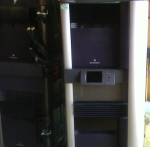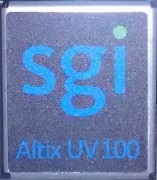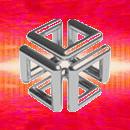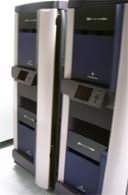Fastest SGI MIPS CPU ever, plus a V10! Still looking for a V12... but too broke to buy any

hinv:
and gfxinfo
recondas also asked me if I could post some more info since it's quite a unique beast - so without further ado-
serial all:
env:
In addition, I discovered something new about the Origin 350: It can have one of three types: Chimera Server (Origin350), Chimera Blade (Onyx350 IP?) - happens when V10 is inserted, and Rackmount WS (I assume this is a Tezro) - Activated by inserting the V10 and running "make rmws 1" on the L1.
This status can be viewed from the brick command, for example:
I was wrong - Rackmount WS sytems *can* learn serials from L2s - as long as the serial begins with a P rather than an M. Thanks to recondas for noticing this.
When a headless O350 has make rmws 1 set on it, its type is still "Chimera Server" but it gains the ability to also accept a P-prefix, allowing it to be linked to a headed system for a NUMA-linked Tezro. Sadly I think this configuration won't extend beyond 2 systems due to r-brick serial security - but I may be proven wrong again. I don't have an R-brick or enough O350-bricks to test with.
Details on the V10 hack can be found at: viewtopic.php?f=3&t=16719768 for the curious.

hinv:
Code: Select all
4 1.0 GHZ IP35 Processors
CPU: MIPS R16000 Processor Chip Revision: 3.0
FPU: MIPS R16010 Floating Point Chip Revision: 3.0
Location: /hw/module/001c01/node/cpubus/0/a
CPU 0 at Module 001c01/Slot 0/Slice A: 1.0 Ghz MIPS R16000 Processor Chip (enabled)
Processor revision: 3.0. Scache: Size 16 MB Speed 333 Mhz Tap 0x15
Location: /hw/module/001c01/node/cpubus/1/a
CPU 1 at Module 001c01/Slot 0/Slice C: 1.0 Ghz MIPS R16000 Processor Chip (enabled)
Processor revision: 3.0. Scache: Size 16 MB Speed 333 Mhz Tap 0x15
Location: /hw/module/001c02/node/cpubus/0/a
CPU 2 at Module 001c02/Slot 0/Slice A: 1.0 Ghz MIPS R16000 Processor Chip (enabled)
Processor revision: 3.0. Scache: Size 16 MB Speed 333 Mhz Tap 0x15
Location: /hw/module/001c02/node/cpubus/1/a
CPU 3 at Module 001c02/Slot 0/Slice C: 1.0 Ghz MIPS R16000 Processor Chip (enabled)
Processor revision: 3.0. Scache: Size 16 MB Speed 333 Mhz Tap 0x15
Main memory size: 4096 Mbytes
Instruction cache size: 32 Kbytes
Data cache size: 32 Kbytes
Secondary unified instruction/data cache size: 16 Mbytes
Location: /hw/module/001c01/node/memory
Memory at Module 001c01/Slot 0: 2048 MB (enabled)
Bank 0 contains 512 MB (Premium) DIMMS (enabled)
Bank 1 contains 512 MB (Premium) DIMMS (enabled)
Bank 2 contains 512 MB (Premium) DIMMS (enabled)
Bank 3 contains 512 MB (Premium) DIMMS (enabled)
Location: /hw/module/001c02/node/memory
Memory at Module 001c02/Slot 0: 2048 MB (enabled)
Bank 0 contains 512 MB (Premium) DIMMS (enabled)
Bank 1 contains 512 MB (Premium) DIMMS (enabled)
Bank 2 contains 512 MB (Premium) DIMMS (enabled)
Bank 3 contains 512 MB (Premium) DIMMS (enabled)
Integral SCSI controller 3: Version IDE (ATA/ATAPI) IOC4
CDROM: unit 0 on SCSI controller 3
Integral SCSI controller 2: Version IDE (ATA/ATAPI) IOC4
CDROM: unit 0 on SCSI controller 2
Integral SCSI controller 4: Version QL12160, low voltage differential
Disk drive: unit 1 on SCSI controller 4 (unit 1)
Disk drive: unit 2 on SCSI controller 4 (unit 2)
Integral SCSI controller 5: Version QL12160, low voltage differential
Integral SCSI controller 0: Version QL12160, low voltage differential
Disk drive: unit 1 on SCSI controller 0 (unit 1)
Disk drive: unit 2 on SCSI controller 0 (unit 2)
Integral SCSI controller 1: Version QL12160, single ended
IOC3/IOC4 serial port: tty3
IOC3/IOC4 serial port: tty4
IOC3/IOC4 serial port: tty5
IOC3/IOC4 serial port: tty6
IOC3/IOC4 serial port: tty7
IOC3/IOC4 serial port: tty8
IOC3/IOC4 serial port: tty9
IOC3/IOC4 serial port: tty10
Graphics board: V10
Gigabit Ethernet: tg1, module 001c02, PCI bus 1 slot 4
Integral Gigabit Ethernet: tg0, module 001c01, PCI bus 1 slot 4
Iris Audio Processor: version EMU revision A4, number 2
PCI Adapter ID (vendor 0x10a9, device 0x100a) PCI slot 1
PCI Adapter ID (vendor 0x1077, device 0x1216) PCI slot 3
PCI Adapter ID (vendor 0x14e4, device 0x1645) PCI slot 4
PCI Adapter ID (vendor 0x10a9, device 0x100a) PCI slot 1
PCI Adapter ID (vendor 0x1077, device 0x1216) PCI slot 3
PCI Adapter ID (vendor 0x14e4, device 0x1645) PCI slot 4
PCI Adapter ID (vendor 0x1102, device 0x0004) PCI slot 1
PCI Adapter ID (vendor 0x1102, device 0x7003) PCI slot 1
PCI Adapter ID (vendor 0x1102, device 0x4001) PCI slot 1
PCI Adapter ID (vendor 0x1033, device 0x0035) PCI slot 2
PCI Adapter ID (vendor 0x1033, device 0x0035) PCI slot 2
PCI Adapter ID (vendor 0x1033, device 0x00e0) PCI slot 2
IOC4 firmware revision 83
IOC4 firmware revision 83
IOC3/IOC4 external interrupts: 2
IOC3/IOC4 external interrupts: 1
Location: /hw/module/001c01/node/hub
HUB in Module 001c01/Slot 0: Revision 2 Speed 200.00 Mhz (enabled)
Location: /hw/module/001c02/node/hub
HUB in Module 001c02/Slot 0: Revision 2 Speed 200.00 Mhz (enabled)
Location: /hw/module/001c01/node/prom
IP35prom in Module 001c01/Slot n0: Revision 6.210
Location: /hw/module/001c02/node/prom
IP35prom in Module 001c02/Slot n0: Revision 6.210
USB controller: type OHCI
USB Human Interface Device: device id 3 type keyboard
USB Human Interface Device: device id 1 type mouse
USB Human Interface Device: device id 2 type keyboard
USB controller: type OHCI
USB Human Interface Device: device id 1 type tablet
and gfxinfo
Code: Select all
Graphics board 0 is "ODYSSEY" graphics.
Unmanaged 1280x1024
BUZZ version B.1
PB&J version 1
32MB memory
Banks: 2, CAS latency: 3
recondas also asked me if I could post some more info since it's quite a unique beast - so without further ado-
serial all:
Code: Select all
Data Location Value
------------------------------ ------------ --------
Local System Serial Number NVRAM M1234567
Reference System Serial Number Attached L2 M1234567
Local Brick Serial Number EEPROM NGLxxx
Reference Brick Serial Number NVRAM NGLxxx
EEPROM Product Name Serial Part Number Rev T/W
---------- -------------- ------------- -------------------- --- ------
INTERFACE 2U_INT_53 NGL666 030_1809_005 A 00
IO9 IO9 NST803 030_1771_005 B 00
ODYSSEY ASTODYB MLV782 030_1725_001 F 00
RISER 2U_RISER NRP608 030_1808_006 B 00
NODE IP59_2CPU NMM411 030_2059_002 A 00
SNOWBALL no hardware detected
PS 1 no hardware detected
PS 2 DPS-500EBE XPD0514006096 060-0178-003 S4
EEPROM JEDEC-SPD Info Part Number Rev Speed SGI
---------- ------------------------ ------------------ ---- ------ --------
DIMM 0 7F7FFE000000000012003413 CM2203B1 2 8.0 N/A
DIMM 2 7F7FFE000000000012003412 CM2203B1 2 8.0 N/A
DIMM 4 no hardware detected
DIMM 6 no hardware detected
DIMM 1 7F7FFE000000000012003417 CM2203B1 2 8.0 N/A
DIMM 3 7F7FFE000000000012003416 CM2203B1 2 8.0 N/A
DIMM 5 no hardware detected
DIMM 7 no hardware detected
env:
Code: Select all
001c02:
Environmental monitoring is enabled and running.
Description State Warning Limits Fault Limits Current
-------------- ---------- ----------------- ----------------- -------
1.8V Enabled 10% 1.62/ 1.98 20% 1.44/ 2.16 1.763
12V <not present>
12V #2 Enabled 10% 10.80/ 13.20 20% 9.60/ 14.40 12.000
3.3V Enabled 10% 2.97/ 3.63 20% 2.64/ 3.96 3.320
12V IO Enabled 10% 10.80/ 13.20 20% 9.60/ 14.40 11.938
5V AUX Enabled 10% 4.50/ 5.50 20% 4.00/ 6.00 5.044
3.3V AUX Enabled 10% 2.97/ 3.63 20% 2.64/ 3.96 3.268
PCI 5V AUX Enabled 10% 4.50/ 5.50 20% 4.00/ 6.00 5.044
PCI 3.3V Enabled 10% 2.97/ 3.63 20% 2.64/ 3.96 3.285
PCI 2.5V Enabled 10% 2.25/ 2.75 20% 2.00/ 3.00 2.483
PCI 5V Enabled 10% 4.50/ 5.50 20% 4.00/ 6.00 4.966
XIO 12V BIAS Enabled 10% 10.80/ 13.20 20% 9.60/ 14.40 12.000
XIO 5V Enabled 10% 4.50/ 5.50 20% 4.00/ 6.00 4.966
XIO 2.5V Enabled 10% 2.25/ 2.75 20% 2.00/ 3.00 2.470
XIO 3.3V AUX Enabled 10% 2.97/ 3.63 20% 2.64/ 3.96 3.320
IP59 3.3V AUX Enabled 10% 2.97/ 3.63 20% 2.64/ 3.96 3.285
IP59 5V AUX Enabled 10% 4.50/ 5.50 20% 4.00/ 6.00 5.044
IP59 12V Enabled 10% 10.80/ 13.20 20% 9.60/ 14.40 12.000
IP59 VCPU Enabled 10% 1.14/ 1.40 20% 1.02/ 1.52 1.297
IP59 SRAM Enabled 10% 2.25/ 2.75 20% 2.00/ 3.00 2.483
IP59 1.5V Enabled 10% 1.35/ 1.65 20% 1.20/ 1.80 1.480
Description State Warning RPM Current RPM
--------------- ---------- ----------- -----------
FAN 0 EXHST 1 Enabled 1980 2311
FAN 1 PS Enabled 3200 5192
FAN 2 PCI 1 Enabled 1980 2721
FAN 3 PCI 2 Enabled 1980 2556
FAN 4 ODY Warning 1679 0
FAN 5 N0 LEFT Enabled 1980 3191
FAN 6 N0 CNTR Enabled 1980 2857
FAN 7 N0 RIGHT Enabled 1980 2970
Advisory Critical Fault Current
Description State Temp Temp Temp Temp
----------------- ---------- --------- --------- --------- ---------
0 INTERFACE 0 Enabled [Autofan Control] 70C/158F 43C/109F
1 INTERFACE 1 Enabled [Autofan Control] 70C/158F 45C/113F
2 INTERFACE 2 Enabled [Autofan Control] 70C/158F 34C/ 93F
3 PCI RISER Enabled [Autofan Control] 70C/158F 36C/ 96F
4 ODYSSEY Enabled [Autofan Control] 70C/158F 44C/111F
5 NODE Enabled [Autofan Control] 70C/158F 37C/ 98F
6 BEDROCK Enabled [Autofan Control] 70C/158F 51C/123F
Zone Temp Target Current Zone Fan Curr/Min
Zone Name State Sensors Average Average Index Fan %
--------- -------- ------------ -------- -------- --------- ---------
NODE Enabled 0,1,2,5,6 47C/116F 42C/107F 0 18%/ 18%
PS Enabled 0,1,2,5,6 47C/116F 42C/107F 1 55%/ 55%
PCI Enabled 3 45C/113F 36C/ 96F 2,3 55%/ 55%
ODY Enabled 4 48C/118F 44C/111F 4 55%/ 55%
In addition, I discovered something new about the Origin 350: It can have one of three types: Chimera Server (Origin350), Chimera Blade (Onyx350 IP?) - happens when V10 is inserted, and Rackmount WS (I assume this is a Tezro) - Activated by inserting the V10 and running "make rmws 1" on the L1.
This status can be viewed from the brick command, for example:
Code: Select all
rack: 001, slot: 01, partition: none, type: Rackmount WS [2MB flash], serial:NGLxxx, source: EEPROM
rack: 001, slot: 02, partition: none, type: Chimera Server [2MB flash], serial:NRTxxx, source: EEPROM
I was wrong - Rackmount WS sytems *can* learn serials from L2s - as long as the serial begins with a P rather than an M. Thanks to recondas for noticing this.
When a headless O350 has make rmws 1 set on it, its type is still "Chimera Server" but it gains the ability to also accept a P-prefix, allowing it to be linked to a headed system for a NUMA-linked Tezro. Sadly I think this configuration won't extend beyond 2 systems due to r-brick serial security - but I may be proven wrong again. I don't have an R-brick or enough O350-bricks to test with.
Details on the V10 hack can be found at: viewtopic.php?f=3&t=16719768 for the curious.


 <>
<>






 machine.
machine.


























 J5600, 2 x Mac, 3 x SUN, Alpha DS20E, Alpha 800 5/550, 3 x RS/6000, Amiga 4000 VideoToaster, Amiga4000 -030, 733MHz Sam440 AmigaOS 4.1 update 1.
J5600, 2 x Mac, 3 x SUN, Alpha DS20E, Alpha 800 5/550, 3 x RS/6000, Amiga 4000 VideoToaster, Amiga4000 -030, 733MHz Sam440 AmigaOS 4.1 update 1.
 Tandem Himalaya S-Series Nonstop S72000 ServerNet.
Tandem Himalaya S-Series Nonstop S72000 ServerNet.